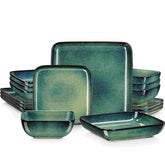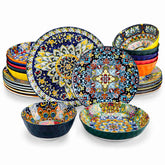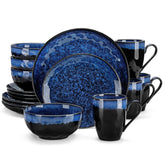Exploring the Intersection of Culture and Tableware: How Different Regions Influence Stoneware Designs
Throughout human history tableware exceeded its functional role by becoming an essential vessel for cultural expression and aesthetic creativity. Stoneware preserves detailed cultural fingerprints because its creation mirrors the geographical conditions and the social values of the producing communities. Every dish, cup and bowl communicates historical heritage through its structure.
The growing adoption of international design trends makes understanding various stoneware origins essential for enhancing our appreciation of dining plates. This blog will navigate through the cultural heritage of stoneware using a historical exploration along with a guide to select pottery pieces that match your appreciation for world artistic traditions.
Why Culture Shapes Stoneware
The evolution of pottery has been driven by cultural forces because societies have continuously adapted their pottery to fulfill their practical needs as well as their artistic and spiritual requirements.
Throughout history, communities relied on distinctive clay and mineral sources which caused different regional variations in their stoneware textures and colors and designs. The climate of regions with high humidity required stoneware that could safely store food and liquids which led to the development of thicker walls and tighter seals.
The production of pottery served as an essential part in cultural religious ceremonies. Asian tea culture transformed Japanese stoneware into central symbolic objects for spiritual activities during the tea ceremony. The people of Africa used ceremonial pots during marriage ceremonies, fertility rituals and harvest celebrations. People in Mediterranean areas employed stoneware pieces during communal dining events to maintain societal bonds through food sharing.
Through its multiple uses stoneware evolved into a symbol that carried cultural expressions combined with artistic values which communities transferred from one generation to the next.
Regional Flavors in Stoneware Design: A Global Tour
East Asian Traditions
The tradition of using stoneware as art continues across East Asian nations like China, Japan, and Korea due to their rich heritage of philosophies and artisan skills.
Japan: Japanese stoneware pottery in Japan follows wabi-sabi principles which value the aesthetic appeal of imperfection. Each dish showcases home-made contours, coarse structures and subtle clay glazes that match the surrounding environment. Two distinct styles demonstrate natural reverence in Japanese pottery: Shino showcases soft thick glazes that crackle while Bizen implements unglazed pottery that bears scars from flames. During tea ceremonies Japanese guests view the natural imperfections of Raku tea bowls as sacred elements which symbolize authentic and simple qualities.
China: The Chinese cultural heritage includes two priceless creations: Yue ware and Yaozhou celadon which showcase perfect green glazes that symbolize pure and virtuous jade. The great level of skill along with detailed patterns and thorough craftsmanship demonstrates the cultural value placed on harmony, symbolism and technical excellence.
Korea: Korean Ongji jars together with Buncheong ware demonstrate an aesthetic charm through their earthy motifs and practical design features which persist in contemporary aesthetics. Natural elements and improvised decorations within pottery express the deep connection of Korean culture to its surroundings and its values of collective existence and nature-based worldview.
Mediterranean Styles
Through the clay works of Greece Italy Spain and other Mediterranean countries we see a carefree approach that infuses their stoneware creations with joyful spirit.
Italy: The ceramic traditions of Southern Italy particularly Puglia showcase hand-painted lemon, olive and vineyard motifs on white backgrounds. The colorful Italian stoneware pottery known as Majolica is a distinct type of tin-glazed pottery.
Greece: The practical value of ancient Greek pottery exceeded its functional uses because ancient makers combined everyday black-figure and red-figure techniques to tell stories about gods and heroes and regular human activities. Modern Greek stoneware combines historical motifs with contemporary color selection to achieve traditional elegance.
Spain: Spanish ceramics from Andalusia combine Moorish artistic elements with Christian design traditions. The Islamic artistic patterns in cobalt blue, green and white combine with robust shapes to represent Spanish communal dining traditions.

African Stoneware
Africa’s diverse stoneware traditions share a central focus on community-oriented storytelling while preserving earth-based artistic approaches.
North Africa: Pottery made by North Africans features hand-carved designs that defend against dangers as well as provide fertility benefits alongside spiritual protection of natural elements.
South Africa: The nations of Nigeria and Ghana create stunning black stoneware through coil-building techniques which they fire in open flames to produce unpredictable patterns and textured surfaces. Vessels in particular carry hand-carved symbols which stand for tribal membership and social ranking.
East and Southern Africa: Women in East and Southern Africa create pottery for ceremonial and everyday use which features decorative elements such as puncture marks and combed lines and cord impressions to enhance tactile experience.
Nordic Design: Scandinavian Minimalism
The long dark winters and cold temperatures throughout Scandinavia led to the development of design principles focused on functional design and muted aesthetics and peaceful atmospheres.
Sweden Denmark and Finland: They produce stoneware with clear lines combined with minimal palette of grays blues whites and organic surface textures. Two examples of Nordic products combining practicality with discreet elegance come from Arabia of Finland and Royal Copenhagen of Denmark.
Citizens of Scandinavia choose stoneware ceramics for spurring hygge living because these items enhance warmth through carefully designed objects that also support comfort and mindfulness.
Rustic European
The rural areas outside the Mediterranean region established their own rustic stoneware traditions which developed independently from the Mediterranean region.
France: French pottery showcases hand-painted roosters and lavender and olives along with warm tones of rustic finishes and earthy hues. French stoneware pottery illustrates the character of country lifestyle through its approachable genuine quality and carefree touch.
England and Germany: English Staffordshire stoneware produced in England maintains its useful characteristics together with delicately painted floral designs but Germany's Westerwald stoneware represents beer-drinking communities with its signature gray-and-cobalt blue decorative scheme.
How Regional Styles Influence Modern Tableware
Designers together with manufacturers use traditional stone influences to produce modern products suitable for current living needs. Minimum-styled collections incorporate Japanese and Scandinavian pottery elements through their natural color schemes and natural form designs.
The arty Mediterranean dining supper sets display Mediterranean brightness through their colorful hand-wrought decorations. Stoneware sets adopting rustic appeal implement textures which resemble African pottery while integrating European rural aesthetics through heavy boundaries and muted waves.
The new wave of handmade products with irregular designs and limited production numbers exists because people around the world now value refined craftsmanship techniques. Modern brands join forces with cultural traditions to combine Mediterranean exuberance with Nordic simplicity into worldwide collections which honor heritage through contemporary design principles.
Choosing Your Stoneware Dinnerware: Finding a Set with Cultural Echoes
The process of selecting stoneware dinnerware requires you to identify sets that reflect cultural traditions. The choice of cultural or tradition-inspired stoneware adds value to mealtimes by bringing historical significance into your dining events. The process to make a well-informed selection follows these steps:
Identify the Aesthetic
Reflect on your preference for either sleek minimalism alongside colorful maximalism or rustic textured simplicity and elaborate patterned designs. People who prefer minimalism often select stoneware with Nordic or Japanese design elements. People who enjoy colorful patterns and storytelling designs should consider Mediterranean or African stoneware.
Glaze and Color Choices
The surface finish of stoneware explicitly shows which cultural heritage it represents:
- Earthy neutrals: Japanese, Nordic.
- Vivid blues and yellows: Mediterranean.
- Deep black, brown, and red tones: African.
- Warm pastels: Rustic European.
Consider the Form and Silhouette
Crude, irregular designs signal that pottery was made by skilled craftspeople of Mediterranean, African or Japanese origin. A minimalist school of design together with functionalism finds expression through rectangles with straight edges (creates a Scandinavian and German character).
Feel Texture and Weight
Texture elements characterized by roughness together with graininess indicate both African and rustic Mediterranean design traditions. The East Asian and Scandinavian design traditions are associated with surfaces that are smooth and refined. Test the pieces by hand before purchase because stoneware needs to satisfy both visual appeal and tactile comfort.
Caring for Your Culturally-Inspired Stoneware Dinnerware
The proper care for stoneware involves gentle hand washing and the avoidance of stiff detergents and abrasive sponge scrubbers. Protect delicate glazes by inserting felt or cloth between stacked pieces while you should allow temperature changes to be gradual to prevent thermal shock. Artisanal stoneware has a small amount of porosity so you should limit soaking time to protect its structural integrity. Proper maintenance of each piece allows it to transform into an important heirloom while providing a meaningful link to cross-cultural traditions and conventional dining customs.
Conclusion
Stoneware serves as much more than functional dinnerware since it offers lasting connections between human cultures and their associated lands as well as traditional ways of life. Culturally-rooted stoneware products bring authentic cultural elements into the everyday life of people who are inspired by Japanese simplicity or Mediterranean color or European rustic charm. Non-disposable handmade stone pottery offers a solution against speedy modern life by enabling both historical admiration and permanent celebration of dining experiences with family members.












